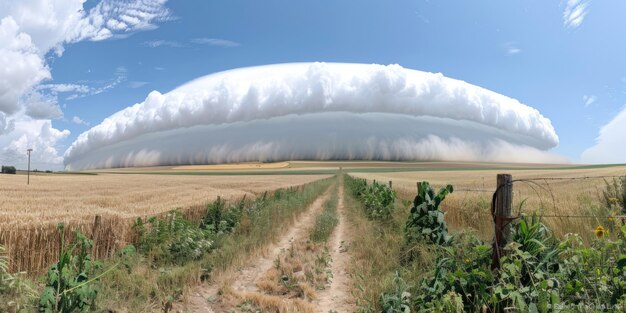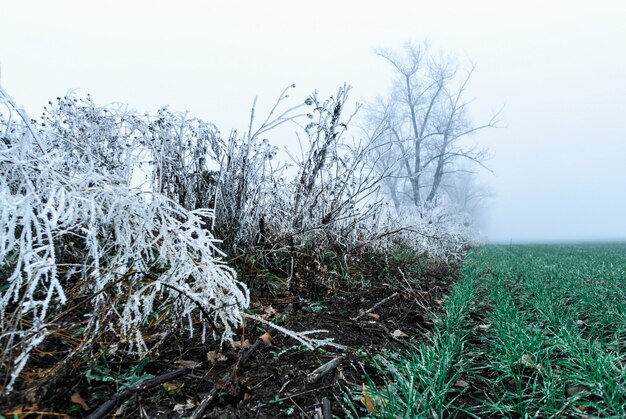The Science Behind Hailstorms: Formation, Risks, and Safety Tips

Hailstorms are severe weather events that involve the formation and fall of hailstones, impacting regions worldwide with potential risks; understanding their formation, associated dangers, and relevant safety measures is vital for safety and minimizing damage.
Have you ever wondered how those balls of ice form during a summer storm? Let’s delve into the fascinating science behind hailstorms: formation, risks, and safety tips to understand and stay safe.
The Genesis of Hailstorms: How Hailstones Form
Hailstorms are a fascinating yet destructive weather phenomenon. They are not simply frozen raindrops; rather, hailstones undergo a complex formation process within thunderstorms.
Understanding this process can help us appreciate the power of nature and better prepare for these events.
The Role of Updrafts
Strong updrafts within thunderstorms are crucial for hail formation. These updrafts are powerful currents of air that push water droplets high into the atmosphere, well above the freezing level.
Supercooled Water
In the upper reaches of a thunderstorm, water droplets can exist in a supercooled state, meaning they remain liquid even at temperatures below freezing. These supercooled droplets are essential for the next stage of hail formation.
- Initial Freezing: A supercooled water droplet collides with an ice crystal or a freezing nucleus.
- Accretion: The droplet freezes onto the ice crystal, causing it to grow larger.
- Layering: As the hailstone is repeatedly lifted and dropped within the storm, it accumulates more layers of ice, resulting in the characteristic layered structure of hailstones.

This cycle continues until the hailstone becomes too heavy for the updrafts to support, at which point it falls to the ground as hail. The size of a hailstone is directly related to the strength and duration of the updrafts within the thunderstorm.
Factors Influencing Hailstorm Severity
The severity of a hailstorm depends on several factors that contribute to the size, density, and overall impact of the hailstones. These factors interact in complex ways to produce a wide range of hailstorm intensities.
Understanding these influences helps meteorologists predict and prepare for potentially damaging hailstorms.
Atmospheric Conditions
The atmospheric conditions present during thunderstorm formation play a crucial role in determining the potential for severe hail. Key conditions include atmospheric instability, moisture content, and temperature profiles.
High levels of instability mean that parcels of air readily rise, enhancing the strength of updrafts. Ample moisture provides the necessary water vapor to form large hailstones, and specific temperature profiles support the development of supercooled water droplets.
Vertical Wind Shear
Vertical wind shear, which refers to changes in wind speed and direction with altitude, is another critical factor. Wind shear can help organize thunderstorms, making them more persistent and allowing them to produce larger hailstones.
- Storm Organization: Wind shear can help separate the updraft and downdraft regions of a thunderstorm, preventing the storm from dissipating quickly.
- Updraft Intensification: Stable storm structures created by wind shear can lead to stronger and more sustained updrafts, allowing hailstones to grow larger.
- Storm Duration: Longer-lived storms have a greater opportunity to produce significant amounts of hail.
By examining these conditions, meteorologists can more accurately forecast the potential for severe hailstorms, giving communities more time to prepare and take necessary precautions.
Geographical Distribution: Hailstorm Hotspots
Hailstorms are not uniformly distributed across the globe; certain regions are more prone to these events due to their geographical and atmospheric characteristics.
Knowing where hailstorms are most frequent can help residents and businesses in these areas better prepare for and mitigate the risks associated with hail damage.
“Hail Alley” in the United States
In the United States, the area known as “Hail Alley” is particularly susceptible to hailstorms. This region includes parts of Colorado, Nebraska, Wyoming, and Kansas.
The unique combination of altitude, temperature gradients, and moisture from the Gulf of Mexico creates ideal conditions for severe thunderstorm development and hail formation.
Global Hailstorm Prone Areas
Outside of the U.S., other regions around the world experience significant hailstorm activity. These areas often share similar atmospheric and geographic characteristics.
Countries such as Argentina, South Africa, and parts of India and China are known for their high incidence of hailstorms
- Argentina: The Andes Mountains play a role in enhancing thunderstorm activity and hail formation in parts of Argentina.
- South Africa: The high altitude and subtropical climate contribute to frequent and severe hailstorms.
- India and China: The monsoon season, coupled with mountainous terrain, can lead to intense thunderstorm development and hail.
Studying the distribution patterns of hailstorms helps researchers understand the underlying climatic and geographic factors that contribute to their formation, leading to improved forecasting and preparedness efforts worldwide.
The Destructive Power of Hail: Assessing the Risks
Hailstorms pose a variety of risks to both property and people. The extent of damage can range from minor inconveniences to significant financial losses and even physical harm.
Understanding these risks is essential for taking appropriate protective measures.
Agricultural Damage
Agriculture is one of the sectors most vulnerable to hail damage. Hailstones can destroy crops, damage orchards, and injure livestock, leading to substantial economic losses for farmers.
The timing of a hailstorm is particularly critical; a severe hailstorm just before harvest can decimate an entire season’s worth of work. In some cases, hail damage can lead to food shortages and price increases.

Property Damage
Hailstorms can cause extensive damage to buildings, vehicles, and other property. Roofs are particularly susceptible, with hailstones capable of cracking tiles, puncturing shingles, and causing leaks.
Roofs are particularly susceptible, with hailstones capable of cracking tiles, puncturing shingles, and causing leaks. Vehicles can also suffer dents, shattered windshields, and broken lights.
Severe hailstorms can even break windows and damage siding, leading to costly repairs. The insurance industry often bears a significant burden following major hailstorm events.
Safety Measures During a Hailstorm
Knowing what to do during a hailstorm can significantly reduce the risk of injury and minimize property damage. Taking proactive safety measures is crucial for protecting yourself and your belongings.
Here are some key steps to follow when a hailstorm approaches or is underway.
Seeking Shelter
The most important safety measure during a hailstorm is to seek shelter immediately. Find a sturdy building or vehicle to protect yourself from the falling hailstones.
If you are caught outdoors without immediate access to shelter, try to find a low-lying area or cover your head and face with your arms to minimize injury.
- Stay Indoors: Remain inside until the hailstorm has completely passed.
- Secure Windows and Doors: Close all windows and doors to prevent hailstones from entering and causing damage.
- Move Vehicles: If possible, move vehicles into a garage or under a carport to protect them from hail damage.
Staying informed about weather alerts and having a plan in place can make a significant difference in ensuring your safety during a hailstorm.
Technological Advances in Hailstorm Prediction
Advancements in weather forecasting technology are continually improving our ability to predict hailstorms. These improvements are essential for providing timely warnings and enabling communities to prepare effectively.
From advanced radar systems to sophisticated computer models, technology is playing a key role in enhancing hailstorm prediction.
Doppler Radar
Doppler radar is a powerful tool for detecting and analyzing thunderstorms. It can measure the velocity of precipitation particles, providing valuable insights into the structure and intensity of storms.
By detecting rotation within a storm, Doppler radar can help identify potential areas for hail formation. It can also estimate the size and concentration of hailstones, improving the accuracy of hailstorm warnings.
Computer Models
Sophisticated computer models are used to simulate atmospheric conditions and predict the development of thunderstorms. These models take into account a wide range of factors, including temperature, humidity, wind, and pressure.
By running high-resolution simulations, meteorologists can identify areas with a high likelihood of hailstorm formation. These models are constantly being refined and improved as more data becomes available.
“`html
| Key Point 🔑 | Brief Description 📝 |
|---|---|
| Formation Process 🧊 | Updrafts lift water droplets to freezing levels. Supercooled water accretes around ice nuclei, forming layers. |
| Influencing Factors 🌪️ | Atmospheric instability, moisture levels, and vertical wind shear influence hailstorm severity. |
| Global Hotspots 🌍 | “Hail Alley” in the US, Argentina, South Africa, and parts of India/China are prone to hailstorms. |
| Safety Tips 🛡️ | Seek shelter, protect property, and stay informed during a hailstorm to minimize risks. |
“`html
Frequently Asked Questions (FAQs)
▼
Hailstorms are caused by strong updrafts in thunderstorms carrying water droplets high into the atmosphere, where they freeze and grow as they collide with supercooled water. Once the hailstones become too heavy, they fall to the ground.
▼
Hailstones can range in size from pea-sized to as large as grapefruits. The largest officially recorded hailstone in the United States weighed nearly two pounds and measured 8 inches in diameter, causing significant damage.
▼
If caught in a hailstorm while driving, pull over to a safe location, away from trees and power lines. Angle your vehicle to minimize the surface area exposed to the hail and protect your head and face with your arms or a blanket.
▼
Meteorologists use advanced tools like Doppler radar and computer models to predict hailstorms. While predicting the exact location and size of hail is challenging, these technologies help issue timely warnings to affected areas, allowing people to prepare.
▼
To protect your home from hail damage, ensure your roof is in good repair and consider using hail-resistant roofing materials. Cover windows with shutters or impact-resistant film, and trim trees that overhang your property to prevent falling branches from causing damage.
“`
Conclusion
Understanding the science behind hailstorms, from their formation to the risks they pose, is crucial for mitigating potential damage and ensuring personal safety. By staying informed and taking proactive measures, communities can better prepare for and respond to these powerful weather events.





